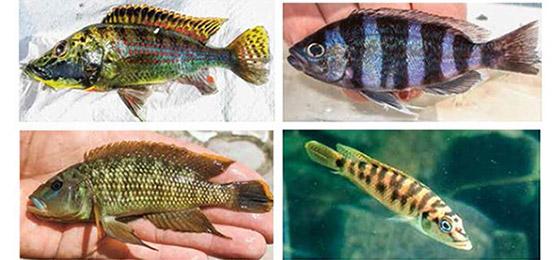The rapid evolution of aquarium fish

The cichlids of East Africa are more than just popular aquarium fish: their many colours and forms offer a good example of the swiftness of evolution. Fabrizia Ronco is a doctoral student at the Zoological Institute of the University of Basel and is studying their speciation. In order to do this, she collects the DNA of cichlids from African lakes.
(From "Horizons" no. 105, June 2015)"After Lake Baikal, Lake Tanganyika is the second-largest freshwater lake in
the world, and it contains some of the world’s richest biodiversity. We are researching the results of some 12 million years of fish evolution there. In this relatively
short timeframe, some 250 species of cichlids have developed. Such a species
explosion takes place when a group of animals settles in a new ecological niche and
adjusts to its new environmental conditions. The best-known examples of this
are the Darwin finches on the Galapagos Islands and the object of our own study, the
cichlids in the East African lakes.
"The cichlids were able to settle in this new ecological niche by developing a new
feature: a second jawbone set deep in their gullet, rather like that of the monster in
the science-fiction film Alien. These pharyngeal jaws are specialised in chewing,
which means that their front jaws were able to adapt to catching and processing
food in all kinds of ways. There are cichlids with extendable mouths that can eat by
going over the sandy bottom like a vacuum cleaner. Others use their round mouths to
scrape away the scales of fishes, while the so-called eye-biters go for the corneas of
fish eyes.
"I catch cichlids in Lake Tanganyika at least twice a year, then I bring them back
to the University of Basel and extract DNA from their fins. Our goal is to get to know
the genetic constitution of all the species in the lake and to understand the paths
chosen by evolution when developing their different colours and forms. In Africa,
we primarily work at ‘Toby’s place’, a former fish farm in Zambia on the southern
banks of the lake. Toby was a fish exporter who provided cichlids for the aquariums
of fish-lovers all over the world. This site lies roughly an hour by boat from the next
coastal town. There are no roads and there is no electricity supply, but there are stone
houses with thatched roofs and two hours of electricity each day from a generator. The irrigation system has created an oasis in the dry surroundings, so vervet monkeys
come there to feed on fruit. You have to get used to the insects and the other small
creatures. Before you get dressed you’ve got to turn your boots upside down and tap
them, so as to empty out any scorpions that might have hidden in them.
"‘Toby’s place’ lies 20 hours by bus and boat from Lusaka, the capital city of Zambia.
In order for local researchers to be able to profit from our work too, we work together
with colleagues from the University of Lusaka and with the local fishing authorities.
This year, we managed to explore the Zambian coast of the lake with a boat. Our
captain was Heinz Büscher from Pratteln in the canton of Basel-Landschaft, a retired
cichlid expert who makes underwater films and who has discovered sixteen new species of fish. Büscher always spends the night on his boat. Together with my colleagues Walter Salzburger and Adrian Indermaur, I slept at night on the beach or in the villages. The people live from the lake and the fields. They mostly laugh at our sun lotions and our antimalarial medication. A local said to us: ‘Malaria isn’t my friend, but it’s my constant companion’, and almost everyone suffers from malaria for a few weeks each year. The diet there consists of maize porridge or rice and fish. It’s
hardly worth eating cichlids because most of them are so small; the large ones taste all the better, however. I did see children with bloated stomachs, too. But mostly the people look happy, and everyone is very interested
in the work we are doing.
“I’m planning three more expeditions to the shores of the lake in Tanzania and
Zambia. Then we can analyse the genome of most of the cichlids. The species in Congolese territory are a problem for us, because the political instability in the
country means we can’t go there. So, we have to collect whatever we can from the aquariums of the world.